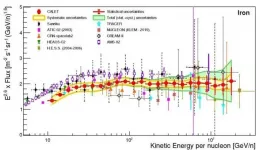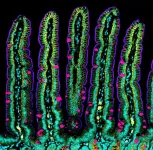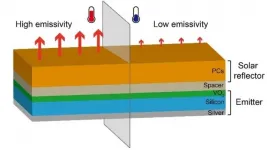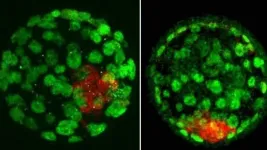New cold atom source lays groundwork for portable quantum devices
Technology advance could enable space-based atomic clocks, improving communications and GPS navigation
2021-06-21
(Press-News.org) WASHINGTON -- Although quantum technology has proven valuable for highly precise timekeeping, making these technologies practical for use in a variety of environments is still a key challenge. In an important step toward portable quantum devices, researchers have developed a new high-flux and compact cold-atom source with low power consumption that can be a key component of many quantum technologies.
"The use of quantum technologies based on laser-cooled atoms has already led to the development of atomic clocks that are used for timekeeping on a national level," said research team leader Christopher Foot from Oxford University in the U.K. "Precise clocks have many applications in the synchronization of electronic communications and navigation systems such as GPS. Compact atomic clocks that can be deployed more widely, including in space, provide resilience in communications networks because local clocks can maintain accurate timekeeping even if there is a network disruption."
In The Optical Society (OSA) journal Optics Express, S. Ravenhall, B. Yuen and Foot describe work carried out in Oxford, U.K. to demonstrate a completely new design for a cold atom source. The new device is suitable for a wide range of cold-atom technologies.
"In this project we took a design we made for research purposes and developed it into a compact device," said Foot. "In addition to timekeeping applications, compact cold-atom devices can also be used for instruments for gravity mapping, inertial navigation and communications and to study physical phenomena in research applications such as dark matter and gravitational waves."
Cooling atoms with light
Although it may seem counterintuitive, laser light can be used to cool atoms to extremely low temperatures by exerting a force that slows the atoms down. This process can be used to create a cold-atom source that generates a beam of laser-cooled atoms directed toward a region where precision measurements for timekeeping or detecting gravitational waves, for example, are carried out.
Laser cooling usually requires a complicated arrangement of mirrors to shine light onto atoms in a vacuum from all directions. In the new work, the researchers created a completely different design that uses just four mirrors. These mirrors are arranged like a pyramid and placed in a way that allows them to slide past each other like the petals of a flower to create a hole at the top of the pyramid through which the cold atoms are pushed out. The size of this hole can be adjusted to optimize the flow of cold atoms for various applications. The pyramid arrangement reflects the light from a single incoming laser beam that enters the vacuum chamber through a single viewport, thus greatly simplifying the optics.
The mirrors, which are located inside the vacuum region of the cold-atom source, were created by polishing metal and applying a dielectric coating. "The adjustability of this design is an entirely new feature," said Foot. "Creating a pyramid from four identical polished metal blocks simplifies the assembly, and it can be used without the adjustment mechanism."
Better measurements with more atoms
To test their new cold-atom source design, the researchers constructed laboratory equipment to fully characterize the flux of atoms emitted through a hole at the apex of the pyramid.
"We demonstrated an exceptionally high flux of rubidium atoms," said Foot. "Most cold-atom devices take measurements that improve with the number of atoms used. Sources with a higher flux can thus be used to improve measurement accuracy, boost the signal-to-noise ratio or help achieve larger measurement bandwidths."
The researchers say that the new source is suitable for commercial application. Because it features a small number of components and few assembly steps, scaling up production to produce multiple copies would be straightforward.
INFORMATION:
Images and engineering drawings of the device are available at https://ora.ox.ac.uk/objects/uuid:2ac612c7-7045-4757-a490-05e61ca551b2.
Paper: S. Ravenhall, B. Yuen, C. Foot, "High-flux, adjustable, compact cold-atom source," Opt. Express, 29, 14, 21143-21159 (2021).
DOI: https://doi.org/10.1364/OE.423662.
About Optics Express
Optics Express reports on scientific and technology innovations in all aspects of optics and photonics. The bi-weekly journal provides rapid publication of original, peer-reviewed papers. It is published by The Optical Society (OSA) and led by Editor-in-Chief James Leger of the University of Minnesota, USA. Optics Express is an open-access journal and is available at no cost to readers online at OSA Publishing.
About The Optical Society
Founded in 1916, The Optical Society (OSA) is the leading professional organization for scientists, engineers, students and business leaders who fuel discoveries, shape real-life applications and accelerate achievements in the science of light. Through world-renowned publications, meetings and membership initiatives, OSA provides quality research, inspired interactions and dedicated resources for its extensive global network of optics and photonics experts. For more information, visit osa.org.
Media Contact:
mediarelations@osa.org
[Attachments] See images for this press release:
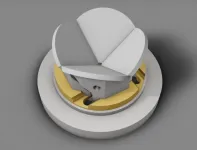
ELSE PRESS RELEASES FROM THIS DATE:
2021-06-21
New findings published this week in Physical Review Letters, Measurement of the Iron Spectrum in Cosmic Rays from 10??GeV/n to 2.0??TeV/n with the Calorimetric Electron Telescope on the International Space Station, suggest that cosmic ray nuclei of hydrogen, carbon and oxygen travel through the galaxy toward Earth in a similar way, but, surprisingly, that iron arrives at Earth differently.
A series of recent publications based on results from the CALorimetric Electron Telescope, or CALET, instrument on the International Space Station, or ISS, have cast new light on the abundance of high-energy cosmic ray nuclei -- atoms stripped of their ...
2021-06-21
The human intestine is made up of more than 40 square meters of tissue, with a multitude of folds on its internal surface that resemble valleys and mountain peaks in order to increase the absorption of nutrients. The intestine also has the unique characteristic of being in a continuous state of self-renewal. This means that approximately every 5 days all the cells of its inner walls are renewed to guarantee correct intestinal function. Until now, scientists knew that this renewal could take place thanks to stem cells, which are protected in the so-called intestinal crypts, and which give rise to new differentiated cells. However, the process that leads to the concave shape of the crypts and the migration of new cells towards the intestinal peaks was unknown.
Now, an international ...
2021-06-21
Extreme heat waves in urban areas are much more likely than previously thought, according to a new modeling approach designed by researchers including University of Illinois Urbana-Champaign Civil and Environmental Engineering (CEE) assistant professor Lei Zhao and alumnus Zhonghua Zheng (MS 16, PhD 20). Their paper with co-author Keith W. Oleson of the National Center for Atmospheric Research, "Large model structural uncertainty in global projections of urban heat waves," is published in the journal Nature Communications.
Urban heat waves (UHWs) can be devastating; a 1995 heat wave in Chicago caused more than 1,000 deaths. Last year's heat wave on the west coast caused wildfires. ...
2021-06-21
In a new publication from Opto-Electronic Advances; DOI https://doi.org/10.29026/oea.2021.200006, Researchers led by Professor Junsuk Rho from Pohang University of Science and Technology (POSTECH), South Korea consider switchable diurnal radiative cooling by doped VO2.
As the impacts of climate change are increasingly felt, thermoregulation technologies that do not consume external energy have attracted considerable attention in the field of energy-saving applications. Radiative cooling has received much research interest for its ability to cool an object even under direct solar illumination. Nanostructured materials, or multi-stacked layers, can be designed to control reflection and emission spectrum ...
2021-06-21
Researchers at Tampere University and their collaborators have shown how spectroscopic measurements can be made much faster. By correlating polarization to the colour of a pulsed laser, the team can track changes in the spectrum of the light by simple and extremely fast polarization measurements. The method opens new possibilities to measure spectral changes on a nanosecond time scale over the entire colour spectrum of light.
In spectroscopy, often the changes of the wavelength, i.e. colour, of a probe light are measured after interaction with a sample. Studying these changes is one of the key methods to gain a deeper understanding of the properties ...
2021-06-21
Biologists at the Universities of Bath and Vienna have discovered 71 new 'imprinted' genes in the mouse genome, a finding that takes them a step closer to unravelling some of the mysteries of epigenetics - an area of science that describes how genes are switched on (and off) in different cells, at different stages in development and adulthood.
To understand the importance of imprinted genes to inheritance, we need to step back and ask how inheritance works in general. Most of the thirty trillion cells in a person's body contain genes that come from both their mother and father, with each parent contributing one version of each gene. The unique combination of genes goes part of ...
2021-06-21
Fat biomolecules in the blood, called "serum lipids," are necessary evils. They play important roles in the lipid metabolism and are integral for the normal functioning of the body. However, they have a darker side; according to several studies, they are associated with various cancers. The medical community has fathoms to go before truly understanding the implications of different serum lipid levels in cancer.
As a major step in this direction, a group of scientists from the Key Laboratory of Carcinogenesis and Translational Research, Laboratory of Genetics, Peking University Cancer Hospital and Institute; Hua County People's Hospital; and Anyang Cancer Hospital, have successfully determined that a family history ...
2021-06-21
(BOSTON) - Research collaborators from the VA, Boston University, and the Concussion Legacy Foundation (CLF) published an inspiring new report today, "1,000 Reasons for Hope," which exclusively details the first 1,000 brain donors studied at the VA-BU-CLF Brain Bank since 2008 and how they have advanced research on concussions and CTE. The report also explains how the next 1,000 brain donors will answer critical questions that take us closer to preventing, diagnosing, and treating CTE, as well as the long-term consequences of concussion and traumatic brain injury.
"Our understanding ...
2021-06-21
Johan Gaume, an EPFL expert in avalanches and geomechanics, has turned his attention to ice. His goal is to better understand the correlation between the size of an iceberg and the amplitude of the tsunami that results from its calving. Gaume, along with a team of scientists from other research institutes, has just unveiled a new method for modeling these events. Their work appears in Communications Earth & Environment, a new journal from Nature Research.
These scientists are the first to simulate the phenomena of both glacier fracture and wave formation when the iceberg falls into the water. "Our goal was to model the explicit interaction between water and ice - but that has a substantial cost in terms of computing time. We therefore decided ...
2021-06-21
An increasing number of studies on artificial intelligence (AI) are published in the dental and oral sciences but aspects of these studies suffer from a range of limitations. Standards towards reporting, like the recently published CONSORT-AI extension, can help to improve studies in this emerging field. Watch authors Falk Schwendicke and Joachim Krois of the Charité - Universitätsmedizin Berlin, Germany, discuss the Journal of Dental Research (JDR) article "Better Reporting of Studies on Artificial Intelligence: CONSORT-AI and Beyond," moderated by JDR Editor-in-Chief Nicholas Jakubovics, Newcastle ...
LAST 30 PRESS RELEASES:
[Press-News.org] New cold atom source lays groundwork for portable quantum devices
Technology advance could enable space-based atomic clocks, improving communications and GPS navigation

